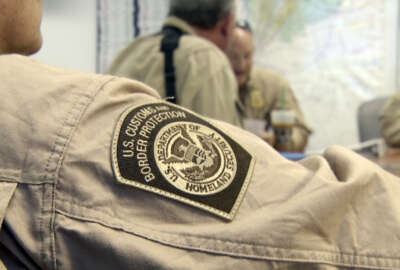
Longtime Air Force IT leader now in the private sector
Bill Marion, managing director of growth and strategy in the Defense and Intelligence practice at Accenture Federal Services, joined the Federal Drive to share his...
Best listening experience is on Chrome, Firefox or Safari. Subscribe to Federal Drive’s daily audio interviews on Apple Podcasts or PodcastOne.
After nearly three decades as a civilian with the Air Force, most recently as deputy chief information officer, Bill Marion followed a familiar path. Now he’s the managing director of growth and strategy in the Defense and Intelligence practice at Accenture Federal Services. He joined the Federal Drive with Tom Temin.
Interview transcript:
Tom Temin: Bill, good to have you as an interview in your post-career.
Bill Marion: Thank you very much.
Tom Temin: So tell us what are you doing at Accenture? Give us the broad picture here.
Bill Marion: Absolutely. Well, first and foremost, just getting to learn Accenture. Frankly, as a transitioning executive, there’s a lot of things that are very similar in the federal space, but a lot of things very new in the Accenture space. So where are the businesses first and foremost, but one of the big things is just getting to know the senior executives and all the technical portfolios, all the business portfolios, and really trying to just orient the vision and mission that Accenture has back to the DoD and the federal space.
Tom Temin: And you’ve probably found with a lot of people that have followed from military service or civilian service in the military into private industry that when you get into large organizations, the similarities sometimes outweigh the differences.
Bill Marion: Absolutely. And frankly, one of the reasons that I joined Accenture was their ability to scale. I mean, they are a global leader in the tech business. I think the Air Force, the Army, the other folks in the federal side, are very similar. So there are a lot of similarities with respect to scale. And frankly, in the DoD space, scale kills. It’s really tough to scale IT at massive scales, and that’s frankly one of the reasons I joined Accenture, because of those strengths.
Tom Temin: Yeah. And one of the things you’re working on is the whole idea of human-centered design and user experience. And I always thought that when designing software or designing any kind of user interaction, whether it’s for your own internal users or deployed to the public, that the idea of the user center is kind of inherent in what you’re doing. So when you distill out this idea of human-centered design, what does it really mean and how can agencies approach it, and how can companies help them get there?
Bill Marion: It should be more intuitive than it has been. I would argue the government’s been really good about putting humans at the center, but not humans at the center of design. So what I mean by that is we put a lot of people into business processes, we have put a lot of people into “making stuff happen,” versus really putting the usability, the user experience, the business processes, the workflows, and things that we’re really leading on, on things like robotic process automation, artificial intelligence, machine learning, reimagining, using design studios, to really take that experience to the next level, I think is really what human-centered design is about–really putting the human and how they want to work, and not saying, “Here’s the business process in the government, here’s the person you go talk to, stand in line, work through that.” So there’s a lot of facets to it on how you do it: imagineering, design boards, all of those things. But fundamentally, it’s getting with your stakeholders, first and foremost–not as much the quintessential builder requirement. For the next year, try to get it perfect. Go through all the implementation and then hand it over to the user, it really almost flips that whole paradigm to say, “I’m gonna work through this with the user first, then kind of imagine with them and design with them how it should work.”
Tom Temin: And if someone is, in an agency, say, is designing a new system, a new interface, to do maybe a new program, but they’re using old existing logic that might be in a hard program system from decades ago, do you find that the low code and no code methodology coupled with what you might have done in that design studio type of concept can marry the two systems so that you get something that works but without having to do a lot of reprogramming even though you’ve done a lot of redesigning?
Bill Marion: Absolutely. We see, and I’ve seen a lot of it even in my short term in the ERP space–what people think is quintessentially legacy–and it’s really not. It’s your logistics, it’s your financials, those things will transcend time. But how do you put design in front of that, bring mobile interfaces? You think of a COVID environment where that interaction has got to be even more seamless because you can’t go walk in to a helpdesk or into a service center. So I think putting the design in the front of an ERP is an example. It may be considered “legacy,” but you can put new interfaces and new ways to interact with that tool to mine all the benefits of the ERP, but also provide an experience that’s actually what they expect to see for an iPhone or surface app.
Tom Temin: We’re speaking with Bill Marion, he’s former deputy Air Force CIO, now managing director of growth and strategy in the defense and intelligence practice at Accenture Federal Services. And let’s talk about the COVID response for a moment. It seems that it has really affected every agency, to say nothing of the contractors, and this effect is ongoing. What are you hearing across the government in the short time you’ve been at Accenture? What are customers generally needing from industry with respect to operating in all of this pandemic?
Bill Marion: Well, certainly the collaboration space, we see multiple news articles–CVR, the collaborative virtual environment that the DoD’s been implementing–I will tell you at Accenture, we live on teams. It allows us to connect in ways–unfortunately, you can’t get too, necessarily, personal like you used to. But it’s a very personal touch. You continue to bring teams together. So that whole collaboration space has continued to go like gangbusters. As we talked about human-centered design, I think we see more and more of that. Again, with these large-scale IT systems, how do you put that human-centered design, that design studio look in front of systems? Because frankly, again, it’s going to be more and more remotes, we have to remove the seams. And the last thing I would say is nothing has slowed down in this business. I mean, if anything it has absolutely accelerated all the digital modernization. I kind of joke with my wife that anywhere from scanning the menu at the restaurant–I mean, that’s an IT system, right? Something’s got to scan, recognize, do all the backend processing to deliver that menu into a restaurant. You’re going to see those kind of use cases, as tactical as it is, over and over and over inside the government, of like when I go and see an airman or a soldier for a task, it’s not going to be that. It’s going to be some kind of IT modernization initiative that’s going to be in front of them.
Tom Temin: And I get the strong sense from many quarters that this is maybe going to settle back a little bit in terms of percentages of people remote and so on. But basically, this new model of a bulk of people or a substantial part of everyone’s workforce, being remote is not actually going to go back to normal with maybe 5 or 10% of people teleworking. That’s your sense?
Bill Marion: Absolutely. I would agree. What the exact numbers are at the end of the day–I think we’ve always seen in tectonic events like this, it will not go back to “normal”; it will be a new normal. Even 10, 20% of the workforce not returning back to your traditional work center will have anything from real estate to workflows to business processes. So I think no matter what happens, whether it’s closer to five or 10%, or closer to 30 or 40%. Again, from our space in Accenture, I mean, we’re seeing continued digital modernization emphasis because it is the new normal, I don’t think we’re going to look back and say it’s just like the industrial era. This is going to be the COVID era that’s going to change the way we fundamentally interact and work together.
Tom Temin: Which brings up the idea of the digital workforce, which is a term I’ve heard and you used it. I’m not sure exactly what it is, maybe you can help us.
Bill Marion: Well, yeah. I kind of joke in my own personal life, everybody’s got an iPad or a surface or something from a 2-year-old to a 100-year-old individual, right? So we have permeated hardware that touch and feel that easy user interface in every spectrum of society, right? What I would call the digital workforce has been extending that into the what I would call the software side of that: Do you have the analytic skills? Do you have the coding skills, the low code, no code kind of capabilities? Do you have design skills? Because everything we do with respect to digital workforce is being able to code in our Python to go into an application and mine the data that we’re trying to build that at simple AI or MLN. So it’s really transending those digital software like skills. Again, it doesn’t have to be have to be a coder, you don’t have to be a cybersecurity guru. But what are those core digital framework skills that need to go across the whole United States, right? Everything we do is going to be more and more digital. Like I said, when you go to the restaurant, do you know how to scan a QR code and then be able to mine the menu out of it? And then, you know only a step later, is going to be pushed on your menu item, pay your bill. At a very basic level, being able to do that seamlessly, we’re not there yet across all facets.
Tom Temin: Yeah, I’m still trying to get my 99-cent coffee to register on my app, so that I get credit for having three cups and I can get my free one a couple of times. So a few gaps here and there. And just getting back to Bill Marion for a moment before we wrap up here: Now that you have growth in your title, that sounds like you might be seeing agencies to make sure that growth happens. From the perspective you have now in the private sector, what do you you wish you had known when you were on the government side, now that you are a contractor, how to best deal, one side with the other?
Bill Marion: The biggest thing I’ve seen on the industry side that I would love to see in government is that the fully enabled collaborative processes. So I think, again, one of the strengths of Accenture, we’re a matrix organization, we bring strings from across a global organization. We don’t really do that well inside the federal space. We have tons of expertise and strengths across federal. We don’t do a good job of really mining it and connecting it. And so, I talk about ways of working…I think Accenture does that really well. It’s just the core of how we operate as a global firm, being able to transcend those thoughts and processes in the federal space, because ultimately, it’s collapsing decisions. It’s making better decisions. It’s mining the experts in your organization. And we still do that very hierarchically. And I think the new tools again, I think COVID will force this–a new way of collaborating and bringing teams together that we’d never imagined before.
Tom Temin: All right, a silver lining. Bill Marion is the former deputy Air Force CIO, now managing director of growth and strategy in the defense and intelligence practice at Accenture Federal Services.
Copyright © 2025 Federal News Network. All rights reserved. This website is not intended for users located within the European Economic Area.
Tom Temin is host of the Federal Drive and has been providing insight on federal technology and management issues for more than 30 years.
Follow @tteminWFED
Related Stories





